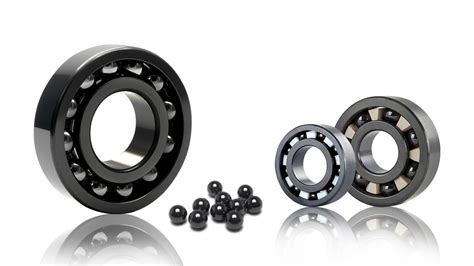Ceramic Bearings: A Comprehensive Guide
Ceramic bearings, renowned for their exceptional performance and extended lifespan, are revolutionizing various industries, including aerospace, medical, and automotive. This comprehensive guide explores the intricacies of ceramic bearings, highlighting their advantages, applications, and maintenance strategies.
Understanding Ceramic Bearings
Ceramic bearings are precision components that utilize ceramic materials, such as silicon nitride (Si3N4) and zirconia (ZrO2), as their rolling elements. These advanced materials exhibit remarkable properties, including:
-
High Hardness: Ceramic bearings surpass traditional steel bearings in hardness, achieving values of up to 1,500 HV, which enhances wear resistance and durability.
-
Lightweight: The density of ceramics is significantly lower than that of steel, making ceramic bearings lighter and reducing rotational inertia.
-
Corrosion Resistance: Ceramic materials possess exceptional corrosion resistance, making them suitable for harsh and demanding environments.
-
Low Thermal Expansion: Ceramic bearings exhibit a low coefficient of thermal expansion, ensuring stable operation under fluctuating temperatures.
The primary components of a ceramic bearing include:
| Component |
Material |
Function |
| Inner Ring |
Steel, Stainless Steel |
Supports the rotating shaft and houses the balls |
| Outer Ring |
Steel, Stainless Steel |
Provides the stationary surface for the bearing |
| Ceramic Balls |
Silicon Nitride, Zirconia |
Reduce friction and facilitate rotation |
| Cage |
Polymer, Metal |
Separates and guides the balls |
Advantages of Ceramic Bearings
Ceramic bearings offer numerous advantages over traditional steel bearings, particularly in demanding applications:

-
Extended Lifespan: Ceramic bearings boast a significantly longer lifespan compared to steel bearings, lasting up to 10 times longer under similar operating conditions.
-
Reduced Friction: The exceptionally smooth surface of ceramic balls minimizes friction, leading to lower operating temperatures and increased energy efficiency.
-
Enhanced Precision: Ceramic bearings maintain tighter tolerances, enabling higher precision and accuracy in applications where rotational stability is crucial.
-
Corrosion Resistance: Ceramic materials are inherently corrosion-resistant, making ceramic bearings ideal for corrosive environments or applications involving exposure to fluids.
-
High-Temperature Performance: Ceramic bearings exhibit superior high-temperature performance, withstanding temperatures up to 1,200°C (2,192°F).
Applications of Ceramic Bearings
Ceramic bearings find extensive use in a wide array of industries due to their unique properties:

-
Aerospace: Ceramic bearings are crucial in aerospace applications, where precision, reliability, and lightweight are paramount. They are used in aircraft engines, landing gears, and flight controls.
-
Medical: Ceramic bearings are highly sought after in medical applications, particularly in surgical tools, implants, and dental equipment, due to their biocompatibility, corrosion resistance, and long lifespan.
-
Automotive: Ceramic bearings are gaining traction in automotive applications, where they improve fuel efficiency, reduce emissions, and enhance handling and performance.
-
Industrial: Ceramic bearings are utilized in various industrial machinery, such as pumps, compressors, and textile equipment, where high precision, low friction, and extended lifespan are essential.
Maintenance of Ceramic Bearings
To ensure optimal performance and longevity, proper maintenance of ceramic bearings is crucial:

-
Lubrication: Ceramic bearings typically require less lubrication than steel bearings, but suitable lubricants should be used, such as polyalphaolefin (PAO) or perfluoropolyethers (PFPE).
-
Cleaning: Regular cleaning of ceramic bearings is essential to remove contaminants and prevent wear. Ultrasonic cleaning is recommended using a suitable cleaning solvent.
-
Inspection: Periodic inspection of ceramic bearings is essential to identify any signs of damage or wear. This includes visual inspection, vibration analysis, and noise monitoring.
Tips and Tricks
-
Proper Installation: Meticulous handling and proper installation techniques are critical to avoid damage to ceramic bearings. Utilize appropriate tools and follow the manufacturer's guidelines.
-
Avoid Shock Loads: Ceramic bearings are sensitive to shock loads, which can cause damage to the balls or rings. Design systems to minimize impact and vibration.
-
Correct Lubrication: The type and quantity of lubricant play a crucial role in the performance of ceramic bearings. Consult with the bearing manufacturer for specific recommendations.
Interesting Stories
-
The Roller Coaster Ride: A ceramic bearing used in a roller coaster experienced extreme temperatures and high-speed rotations. Despite these demanding conditions, the bearing performed flawlessly, ensuring a thrilling and safe ride for passengers.
-
The Submersible Pump: A ceramic bearing installed in a submersible pump operated for over 10 years in harsh underwater conditions. The bearing's corrosion resistance prevented failure, enabling the pump to continue operating seamlessly.
-
The Dental Miracle: A ceramic bearing implanted in a patient's jawbone successfully replaced a damaged joint. The bearing's biocompatibility and superior wear resistance allowed the patient to regain full functionality.
Pros and Cons of Ceramic Bearings
Pros:
- Extended lifespan
- Reduced friction
- Enhanced precision
- Corrosion resistance
- High-temperature performance
Cons:

- Higher initial cost compared to steel bearings
- Sensitivity to shock loads
- Specialized maintenance requirements
Conclusion
Ceramic bearings offer a compelling solution in applications demanding exceptional performance, extended lifespan, and corrosion resistance. Their advanced properties make them invaluable in industries such as aerospace, medical, automotive, and industrial manufacturing. With proper maintenance and installation, ceramic bearings can maximize efficiency, reliability, and longevity in demanding operating conditions.

